Fred Harvey (1835-1901) and the phrase “Fred Harvey era” are often misunderstood and misused when it comes to describing early Native American style jewelry.
Fred Harvey lived during fascinating times and his story tells us much about US transportation, westward travel, railway restaurant cars and the early tourist trade. But what is curious about his legacy is that we Native American jewelry aficionados erroneously use his name to describe a particular type of Native American style tourist jewelry that he personally did not have much to do with and that actually exploded onto the scene after his death.
Instead of referring to the the tourist jewelry from the era as “Fred Harvey jewelry”, it has been suggested that “railroad jewelry” would have been more appropriate. But that’s water over the bridge.
Is Fred Harvey responsible for the introduction of Americans to America? Yes.
Is he responsible for the first Native American jewelry boom in the US? Well, yes and no. But that’s putting the caboose before the engine. To understand the man, the era, and the jewelry, first of all a very brief timeline:

1835 Fred Harvey was born in London, England
1850 Fred Harvey, age 15, sailed to America, his first job was a dishwasher in NYC. He became a US citizen in 1858
1876 Fred Harvey entered into a handshake agreement with restaurant operator Peter Cline who ran the eatery at the Topeka, Kansas railway depot to transform the lunchroom to better serve train passengers. After a radical makeover, he offered a 35 cent breakfast which included steak, eggs, hash browns, six wheat pancakes with maple syrup, apple pie and coffee all served in a clean and pleasant atmosphere.
1878 Fred Harvey signed a contract with the Santa Fe Railway (also known as the Atchison, Topeka & Santa Fe or AT&SF) to operate small restaurants (called tea rooms) at railroad depots along the railroad’s route.

Early Santa Fe Railway
1880 and onward trading post owners (called traders) began carrying tools and supplies for the Native American production of spoons, buttons, squash blossom necklaces, and other jewelry items.
1885 Fred Harvey managed 17 lunchrooms, called Harvey Houses, along Santa Fe’s line. They were run by Harvey Girls, single, young waitresses in starched uniforms.

A Harvey Girl in a Harvey House lunchroom in the early 1900s
1888 Fred Harvey begins to operate dining cars on the Santa Fe Railway. He signed his last contract with the Santa Fe Railroad in 1899. Here is a sample menu from one of the Harvey dining cars.
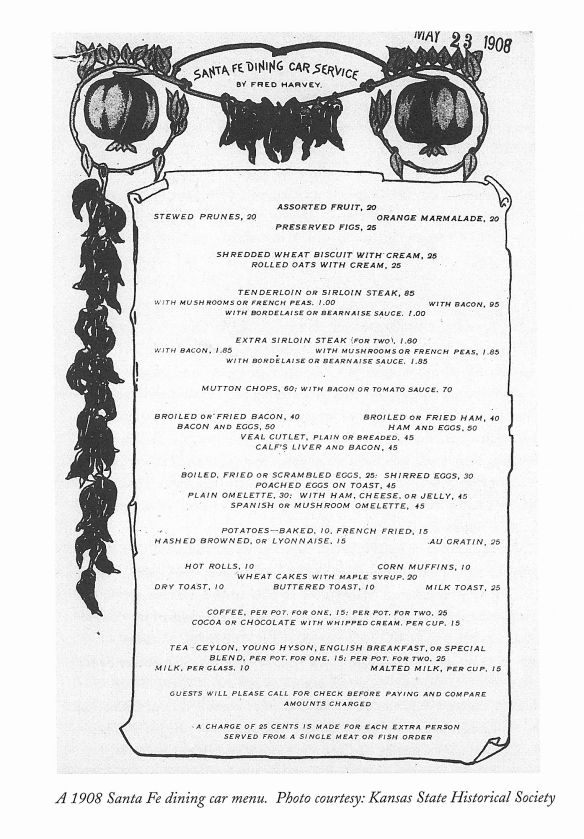

Santa Fe Railway dining car interior – 1890
1899 Fred Harvey Company (notably Indian Jewelry manager Herman Schweizer) supplied pre-cut turquoise and pre-measured silver pieces to traders for the manufacture of lightweight jewelry (aka railroad jewelry) to satisfy the demand of the railroad tourist trade.
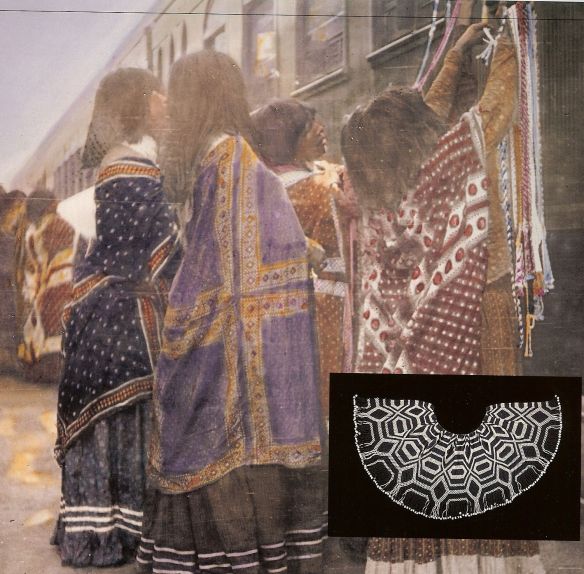
Phoenix early 1900s
1901 Fred Harvey died at age 65. His son, Ford Harvey assumed control of the Fred Harvey Company
1909 The Thunderbird design was copyrighted by Fred Harvey Co.
1920 Fred Harvey Co. is the principal concessionaire in the newly established Grand Canyon National Park.
1923 Maisel’s Indian Trading Post opens in Albuquerque offering coin silver jewelry
1932 Bell Trading Co began operation
1935 Maisel’s merges with Bell Trading Co. and Bell converts to machine manufacturing remaining in business until 1972

Fred Harvey’s main goal as an entrepreneur was to provide good food and good service for railroad travelers. He was immensely successful at that and essentially developed America’s first chain restaurants – Harvey House.
So what does he have to do with the railroad jewelry? He created the market and the place to sell the wares. By making travelers comfortable, well fed and happy, they were ready to purchase souvenirs as mementos of their travels. The lightweight tourist jewelry was sold in the depot hotels and restaurants and alongside the train tracks.

Some of the most popular items were bracelets, pins, spoons, all heavily laden with symbols.
The meanings for these symbols, in a large part, did not come from the Native Americans but were made up by the marketers of the jewelry such as Herman Schweizer of the Fred Harvey Company. He is attributed to say that the very popular Thunderbird symbol was (see the Harvey chart below) the “sacred bearer of happiness unlimited.” That sounds good, I’ll take two.
One of the most popular tourist pieces was the split shank Pretty Girl bracelet.
The peak of the Fred Harvey era tourist-quality Native American style jewelry was from 1900-1930, the decline caused mainly by the closure of the railroad depot lunchrooms and shops. Even so, it continued to be produced until the mid 1940s or 1950s. The Bell Trading Co. continued on until the 1970s.
The authentic, sometimes called ethnographic, Native American jewelry was made before and during the tourist era and continues to be made today. Using heavier silver and stones, authentic Native American jewelry speaks volumes about its heritage and makers.
Fact or Fiction?
The Fred Harvey Company produced Indian jewelry. FALSE
All “Fred Harvey era” southwest jewelry was Indian made. FALSE
Some tourist jewelry is Indian made. TRUE
Paula
References:




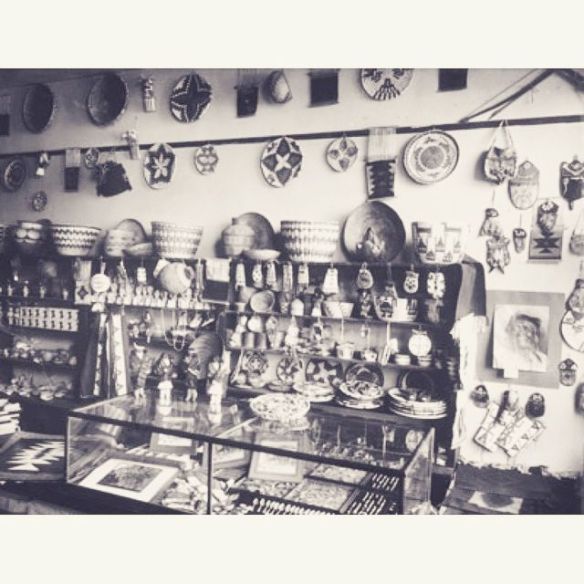

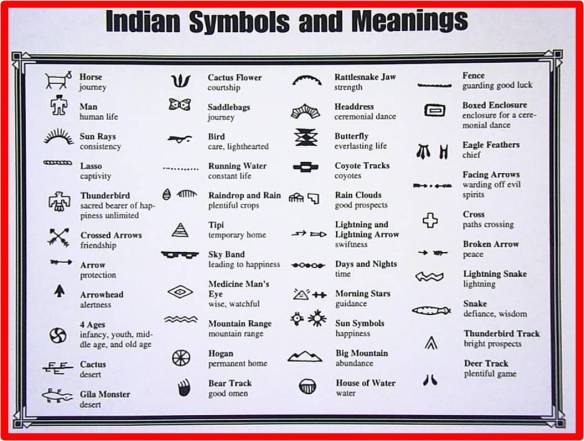
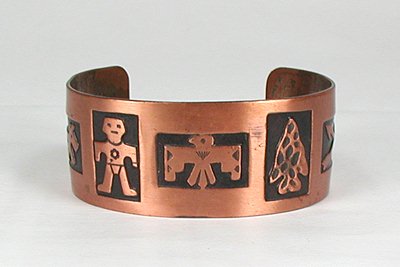

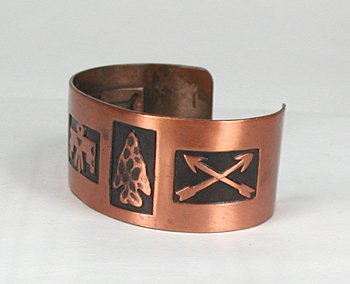

Very well documented! Enjoyed it very much! Thank you!
Thanks, I enjoyed putting it all together. Paula
I enjoyed this so much. Thank you for your time in compiling all of this info. I love reading about Fred Harvey and now I understand him better:O)
Paula – the thunderbird design on the copper cuff in the article is this the exact design copyrighted by Fred Harvey Co.? I have a belt buckle with the EXACT same thunderbird design that I have been trying to identify, I have spent days looking for it and your blog was the only place I have found it. Any help would be appreciated.
Did he ever make children’s rings that were stamped sterling on one side and the box in a box stamp on the other side as a ceremonial dance? Maybe a child’s first dance?
I’m devoting this blog to full length articles on topics related to Native American jewelry and artifacts.
To ask a question about your jewelry or other item, I recommend the Facebook group titled
Native American Jewelry Forum
https://www.facebook.com/groups/411905612155015/
It is a closed group. To join, send a request and I will be happy to approve your addition to the group.
Paula at Horsekeeping
http://www.horsekeeping.com
Just stumbled across this post. Great work and very informative!
Pingback: Repousse | Native American Jewelry Tips
Pingback: Fred Harvey Thunderbird Necklace - Elizabeth Appraisals